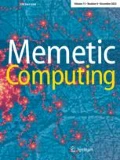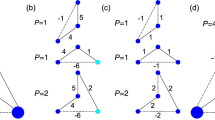Abstract
The maximum clique problem is an important problem in graph theory. Many real-life problems are still being mapped into this problem for their effective solutions. A natural extension of this problem that has emerged very recently in many real-life networks, is its fuzzification. The problem of finding the maximum fuzzy clique has been formalized on fuzzy graphs and subsequently addressed in this paper. It has been shown here that the problem reduces to an unconstrained quadratic 0–1 programming problem. Using a maximum neural network, along with mutation capability of genetic adaptive systems, the reduced problem has been solved. Empirical studies have been done by applying the method on stock flow graphs to identify the collusion set, which contains a group of traders performing unfair trading among themselves. Additionally, it has been applied on a gene co-expression network to find out significant gene modules and on some benchmark graphs.
Similar content being viewed by others
References
Bandyopadhyay S, Bhattacharyya M (2008) Mining the Largest Dense N-vertexlet in a Fuzzy Scale-free Graph. Technical Report No.- MIU/TR-03/08. Machine Intelligence Unit, Indian Statistical Institute, Kolkata, India
Bandyopadhyay S, Bhattacharyya M (2009) A neuro-GA approach for the maximum fuzzy clique problem. In: Köeppen M, Kasabov N, Coghill G (eds) Advances in neuro-information processing, LNCS 5506. Springer, Heidelberg, pp 605–612
Barahona F, Junger M, Reinelt G (1989) Experiments in quadratic 0–1 programming. Math Program 44(2): 127–137
Bomze IM, Budinich M, Pardalos PM, Pelillo M (1999) The maximum clique problem. In: Du DZ, Pardalos PM (eds) Handbook of combinatorial optimization: supplementary volume A. Kluwer Academic, Dordrecht, pp 1–74
Du DZ, Ko KI (2000) Theory of computational complexity. Wiley, New York
Goldberg DE (2005) Genetic algorithms in search, optimization & machine learning. Pearson Education, Ninth Indian Reprint, India
Gutin G, Karapetyan D (2009) A selection of useful theoretical tools for the design and analysis of optimization heuristics. J Memetic Comput 1(1): 25–34
Håstad J (1999) Clique is hard to approximate within n 1–ε. Acta Math 182: 105–142
Hopfield JJ, Tank DW (1985) Neural computation of decisions in optimization problems. Biol Cybern 52: 141–152
Johnson DS, Trick MA, Johnson DJ (1993) Cliques, coloring, and satisfiability: second dimacs implementation challenge. Dimacs Ser Discrete Math Theor Comput Sci 26: 11–13
Lee KC, Funabiki N, Cho YB, Takefuji Y (1991) A parallel neural network computing for the maximum clique problem. In: Proceedings of the international joint conference on neural networks, Singapore, pp 905–910
Lee KC, Funabiki N, Takefuji Y (1992) A parallel improvement algorithm for the bipartite subgraph problem. IEEE Trans Neural Netw 3(1): 139–145
Lee KH (2005) First course on fuzzy theory and applications. Springer, Berlin
Mordeson JN, Nair PS (2000) Fuzzy graphs and fuzzy hypergraphs. Physica-Verlag, Heidelberg
Palshikar GK, Bahulkar A (2000) Fuzzy temporal patterns for analysing stock market databases. In: Proceedings of the international conference on advances in data management, Pune, India, pp 135–142
Palshikar GK, Apte MM (2008) Collusion set detection using graph clustering. Data Mining Knowl Discov 16: 135–164
Rosenfeld A (1975) Fuzzy graphs. In: Tanaka K, Zadeh LA, Fu KS, Shimura M (eds) Fuzzy sets and their applications to cognitive and decision processes. Academic Press, New York, pp 77–95
Rousseeuw P (1987) Silhouettes: a graphical aid to the interpretation and validation of cluster analysis. J Comput Appl Math 20: 53–65
Wang J, Tang Z, Wang R (2004) Maximum neural network with nonlinear self-feedback for maximum clique problem. Neurocomputing 57: 485–492
Wang J, Tang Z, Wang R (2004) A chaotic maximum neural network for maximum clique problem. IEICE Trans Inf Syst E87-D(7): 1953–1961
Wen X, Fuhrman S, Michaels GS, Carr DB, Smith S, Barker JL, Somogyi R (1998) Large-scale temporal gene expression mapping of central nervous system development. Proce Natl Acad Sci USA 95: 334–339
Yang G, Yi J, Gao S, Tang Z (2007) An improved transiently chaotic neural network with multiple chaotic dynamics for maximum clique problem. In: Proceedings of the second international conference on innovative computing, informatio and control, Washington, DC, p 275
Yang G, Tang Z, Yi J (2007) An improved chaotic maximum neural network for maximum clique problem. Int J Comput Sci Netw Secur 7(2): 1–7
Yi J, Yang G, Gao S, Tang Z (2009) A shrinking chaotic maximum neural network for maximum clique problem. Int J Innov Comput Inf Control 5(5): 1213–1229
Zadeh LA (1965) Fuzzy sets. Inf Control 8: 338–353
Author information
Authors and Affiliations
Corresponding author
Rights and permissions
About this article
Cite this article
Bhattacharyya, M., Bandyopadhyay, S. Solving maximum fuzzy clique problem with neural networks and its applications. Memetic Comp. 1, 281–290 (2009). https://doi.org/10.1007/s12293-009-0019-6
Received:
Accepted:
Published:
Issue Date:
DOI: https://doi.org/10.1007/s12293-009-0019-6




